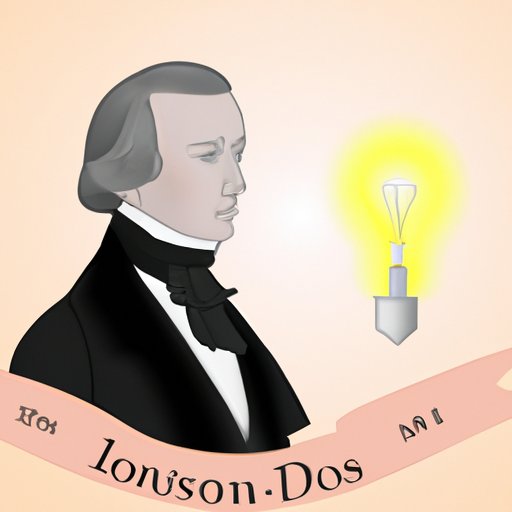Introduction
The lightbulb is one of the most iconic inventions of all time. It has revolutionized the way we live our lives, providing us with a source of illumination that has allowed us to work and play late into the night. But who invented the lightbulb? While many people believe it was Thomas Edison, the truth is more complicated than that.
In this article, we’ll take a look at Thomas Edison’s role in the invention and improvement of the lightbulb. We’ll explore his early life and career, his first successful lightbulb, and his contributions to the development of the lightbulb. We’ll also examine the role of other inventors in developing the lightbulb, beyond Thomas Edison. Finally, we’ll look at how Thomas Edison’s invention of the lightbulb changed the world.
A Historical Look at Thomas Edison and the Invention of the Lightbulb
Thomas Edison was born in 1847 in Milan, Ohio. He showed an early aptitude for science and invention, and by the age of 10 he had already built a laboratory in his family’s basement. At the age of 21, Edison moved to New York City, where he set up his first major invention workshop.
At the time, electricity was still a relatively new concept, and there was a great deal of excitement around its potential applications. Edison began experimenting with ways to use electricity to power a lightbulb. The challenge was that no one had been able to create a bulb that would stay illuminated for more than a few minutes.
In 1879, after a year of experimentation, Edison developed a carbon filament bulb that could stay lit for more than 12 hours. This was a major breakthrough, and it marked the beginning of Edison’s journey to perfecting the lightbulb.
Exploring Thomas Edison’s Contributions to the Development of the Lightbulb
After his initial success, Edison continued to refine his invention. He experimented with different filaments, such as bamboo and carbonized paper, and made several improvements to the design of the bulb. He also improved the electrical wiring and insulation, which helped to make the bulbs more efficient and durable.
Edison’s improvements were so successful that he was awarded a patent for the incandescent lightbulb in 1880. This patent gave him exclusive rights to the technology, and it allowed him to build a business around it.
It’s important to note that Edison did not invent the lightbulb. In fact, he was building on the work of other inventors who had come before him. Despite this, Edison’s work was instrumental in perfecting the lightbulb and making it a practical and reliable source of illumination. As Edison himself said, “Genius is one percent inspiration and ninety-nine percent perspiration.”
The Role of Other Inventors in Developing the Lightbulb, Beyond Thomas Edison
Though Edison is often credited with inventing the lightbulb, other inventors played an important role in its development. One of the most significant contributors was Joseph Swan, a British scientist and inventor. Swan created a carbon filament bulb in 1860, nearly two decades before Edison.
Another key figure in the development of the lightbulb was Humphry Davy, an English chemist who invented an arc lamp in 1809. This lamp used electricity to create a bright arc of light, and it was the first successful electric lighting system.
Though these inventors did not achieve the same level of success as Edison, their contributions were essential in the development of the lightbulb. Without their pioneering work, Edison may never have been able to perfect the lightbulb.
Examining the Impact of Thomas Edison’s Improvements on the Lightbulb
Edison’s improvements to the lightbulb had a dramatic impact on its efficiency, durability, and cost. His bulbs were much brighter and longer lasting than earlier versions, and they were much cheaper to produce. This meant that people could afford to light their homes with electricity for the first time.
Edison’s bulbs also used less energy than earlier versions, which meant that they were more efficient. This was a major improvement over earlier bulbs, which required large amounts of electricity to operate.
How Thomas Edison’s Invention of the Lightbulb Changed the World
Edison’s invention of the lightbulb had a profound effect on the world. It allowed people to work and study late into the night, which increased productivity and opened up new possibilities. It also improved safety and security, as it allowed people to see in dark places.
But perhaps the greatest impact of Edison’s invention was its social and cultural impact. For the first time, people were able to stay up late and enjoy the nightlife. This led to a boom in entertainment, from restaurants and bars to movie theaters and concert halls. It also gave rise to new forms of art and expression, such as neon signs and light shows.
Conclusion
Thomas Edison was an important figure in the development of the lightbulb, but he was not the only one. Other inventors, such as Joseph Swan and Humphry Davy, played a crucial role in perfecting the lightbulb. Edison’s improvements to the lightbulb made it more efficient, durable, and cost-effective, which enabled people to light their homes with electricity for the first time. His invention also had a profound social and cultural impact, changing the way people lived and worked. Edison’s invention of the lightbulb truly changed the world.
(Note: Is this article not meeting your expectations? Do you have knowledge or insights to share? Unlock new opportunities and expand your reach by joining our authors team. Click Registration to join us and share your expertise with our readers.)
